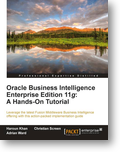The long awaited “Oracle Business Intelligence Enterprise Edition 11g: A Hands-On Tutorial” (Packt publishing) by Christian Screen, Haroun Khan and Adrian Ward was finally released two weeks ago (Amazon) and I got the hard copy delivered today (haven’t tried the Kindle version yet…).
As I have been hanging around Oracle BI and its various ancestors since quite a while I was eagerly looking forward to this one – as well as Marks forthcoming book – for several reasons:
First of all it always boggled my mind as to just how someone would go about packing the OBIEE 11g “basics” into a couple of hundred pages when almost each topic on its own (WLS, security, infrastructure, RPD et.) would easily fill a complete book.
Secondly, as I split my time between projects and training I’m alway interested to see the different approaches taken to convey certain messages, teach certain topics and dispell certain sales claims.
Last but not least…I simply can’t spend that much time on writing these things together (see immediately below).
First impression after a cursory glance at the table of contents and browsing some chapters: thank the heavens that someone took the time to write all of this up an give me a whooping 600+ bound pages to slap people with rather than just saying “RTFM” 🙂 …especially when there wasn’t really any “M” of this kinds o far.
Going end-to-end from explaining the basic architecture, through the installation, the RPD and webcat, action framework and on to OLAP/Essbase integration, the book covers all the basic subjects with a seriously nice hat-tip “Reporting Databases” in chapter 7.
That last one definitely being a chapter which made me smile since more often than not one can see people storming off to “do business intelligence” (read: draw some reports and extryct some lists) without thinking about the basics: the data and the way it is modelled. Always reminds me of a mantra in the old Siebel Analytics courses: “Model first!”
The books is clearly written with the KISS principle in mind and manages to stick to that principle very nicely. The structure’s clear and proper and some of the graphs are especially funny for us old-timers as they point way back to NQuire. Links to detailled descriptions in the official Oracle documentation are provided where necessary and should never be disregarded. This being a hard-copy and OBIEE evolving at a steadily increasing pace, those can come in very handy when analysing a certain component or behaviour in a specific version of the product.
Also, the book provides good links to supporting material; including the complete database, web catalog and styles and skins used for the examples in the book. A very nice touch since this will allow anyone to reproduce things step-by-step rather than having to adapt the books content to his/her own situation or vice versa which is a huge plus for people newly hopping on to the OBIEE train.
I’ve kept it quite high-level since I suspect everyone is clever enough to read the detailled outline in the provided links here and since my judgement is quite simple: if you’re an OBIEE starter: get it. If will help you as a go-to place or aide-mémoire for most “how did this work again?” questions.
If you’re coming from 10g and looking forward to migrating to 11g: get it. It does a good job of painting the big picture, explaining the architecture, the components and how it all works together, thereby taking the edge off “the beast that is 11g” (admit it guys, it can be overwhelming).
Personally, I will definitely use it as supporting material / a hand-out for my beginners courses, bootcamps and onboarding of new team members like I do with Kimballs bible.
So kudos to Christian, Haroun and Adrian! Along with last weeks release of the new 11.1.1.6.2 BP1 Sampleapp v207 this will provide good material for the next couple of rainy days (read: me getting into troubles for hanging around work topics even at home ;-)).
Next up: Marks book. Really looking forward to that one now!
